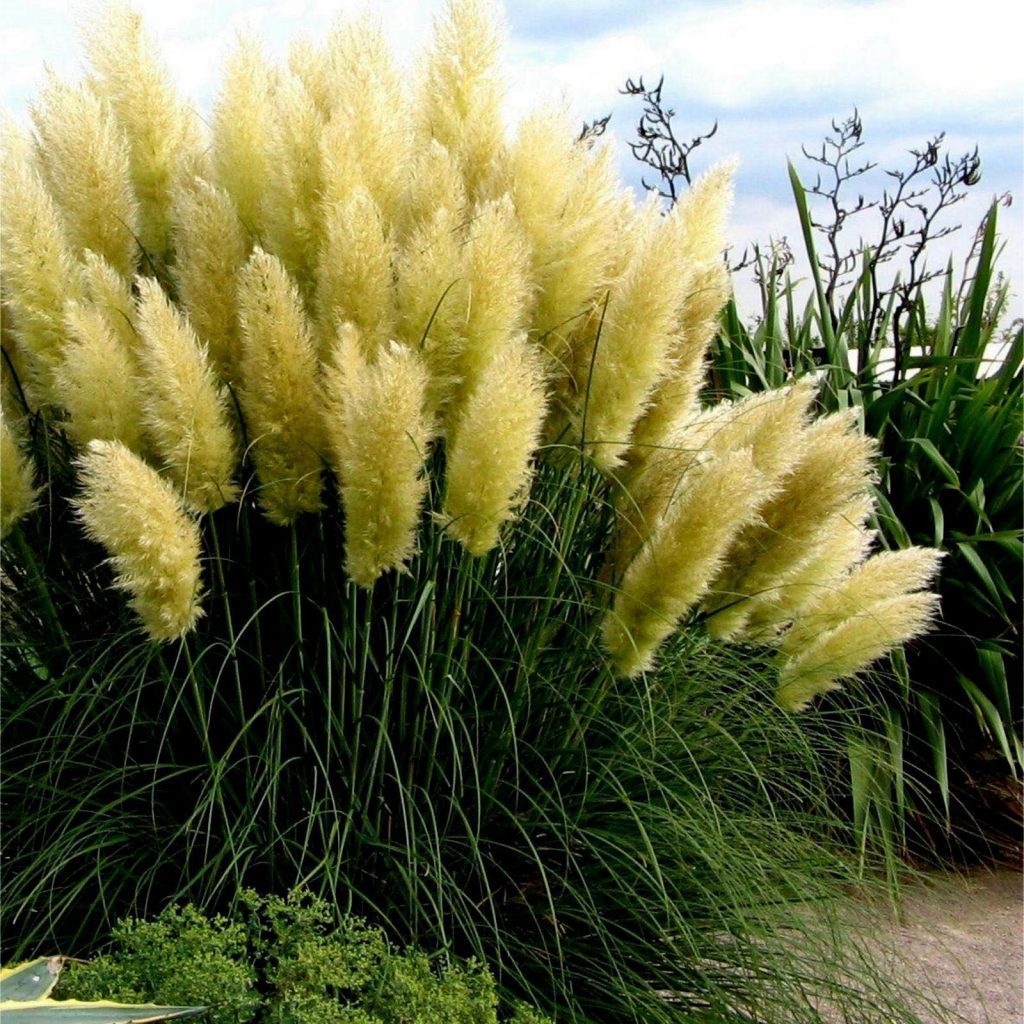Pampas Grass And Other Grasses
Prized or despised, pampas grass must be one of the most misused and misunderstood grasses we grow.
I don’t know why, as They are evergreen, look dramatic, and require little care and attention. In fact, they are the perfect plant.
The problem with pampas is that they usually get planted in the wrong position. They’re big and bold and can easily dwarf everything else around them. Also, they’ve got tough, rough leaves with barbed edges, making them difficult to handle.
The ideal place is well-drained soil in a sunny spot where the wind can’t wreck those glamorous, silky plumes.
Pampas Grass Substitutes
Good ones to grow are the giant Sunningdale Silver, with plumes up to 10ft tall, and the Pumila, which at 4ft tall is great for the smaller garden.
Gold Band has gold-striped leaves that provide a little more interest when the flowers are finished.
If you are tempted to give pampas a try, now is the time to beg a bit from a friend. Cut a section from the edge of a mature plant. Alternatively, grow one from seed. But beware…it will take a few years to grow a great display.
Many gardeners are convinced that they need to set fire to their pampas if they’re to survive the winter weather and throw up blooms next year.
It simply isn’t true and is definitely a risky way of getting rid of dried-up leaves, which can be hard to handle because of the barbed edges.
A much safer way is to put on a pair of strong thorn-proof gloves to cut out the old leaves and flower spikes in early spring, just before the new shoots emerge.
You will still have a blazing display… without having to call on the services of the local fire brigade.
WHAT an exquisite time of year. Trees look their freshest, verges are dotted with buttercups, and the grasses are coming into flower.
For those unaffected by hay fever, grasses are summer’s unsung floral stars.
Large grasses in full bloom can be positively architectural. The biggest of all — but, alas, the most widely planted — is pampas grasses. They’re out of scale for small gardens and, with their razor-sharp leaf edges, notoriously difficult to handle.
That’s a shame because other more elegant grasses make excellent focal points.
SUPER GRASS
Gardeners have flirted with grasses for centuries, but their garden value has been more widely recognised in recent years. Their flowers lack strong colours, but they compensate for that tenfold with subtle foliage tones, distinctive outlines and waving stems.
Grasses tolerate a wide range of conditions. You can grow almost all of them in pots and the ground and can buy specimens in containers all year.
If you keep them well watered after planting, they’ll settle down quickly and provide years of enjoyment. If unsure which varieties will suit, look at the mature, growing plants.
Public gardens and major flower shows will have grasses aplenty since they’re so trendy, and you’ll find them for sale at most good nurseries and garden centres. Choose with care, though, as some are invasive.
The popular green, pink and white-striped Gardener’s Garters has creeping roots that rapidly colonise large areas. Grow it in a half-tub, confined bed or police it ruthlessly.
Other grasses are copious self-seeders. Californian Oryzopsis miliacea has feathery tassels, but, as I learnt to my cost, the seeds endure, even in compost.
Other nuisance-seeders include bronze-tinted Anemanthele lessoniana, silky African love grass Eragrostis curvula and all annual grasses. Among these, I love quaking grass, Stipa maxima, for its trembling, fir-cone flowers, despite the unwanted seedlings.
Living with grass is like any relationship; you have to tolerate its faults, as well as enjoying its virtues.
GREEN GIANTS
BIG grasses — even pampas — are fine if they are in scale. One of the most elegant, with saintly habits, is giant oat, Stipa gigantea. In early summer, 8 ft wands emerge, each waving panicles of translucent, copperhued flowers.
Chinese Miscanthus suits some, but I wouldn’t say I like its coarseness. The sere winter foliage turns a depressing beige, but such varieties as Flamingo and the striped Zebrinus are handsome while green.
If you prefer native plants, Britain has a surprisingly rich choice. In dampish soil, purple moor grass, Molinia caerulea, will grow nearly 6ft high, with nut-brown flowers and stems which turn straw-coloured in autumn.
The prettiest is the hair grasses, Deschampsia caespitosa and D. flexuosa, from wild moors or open woodland.
They are perfect for taming. There are fancy varieties such as Tatra Gold or Goldtau, but the wild ones in our local wood look just as pretty.


























